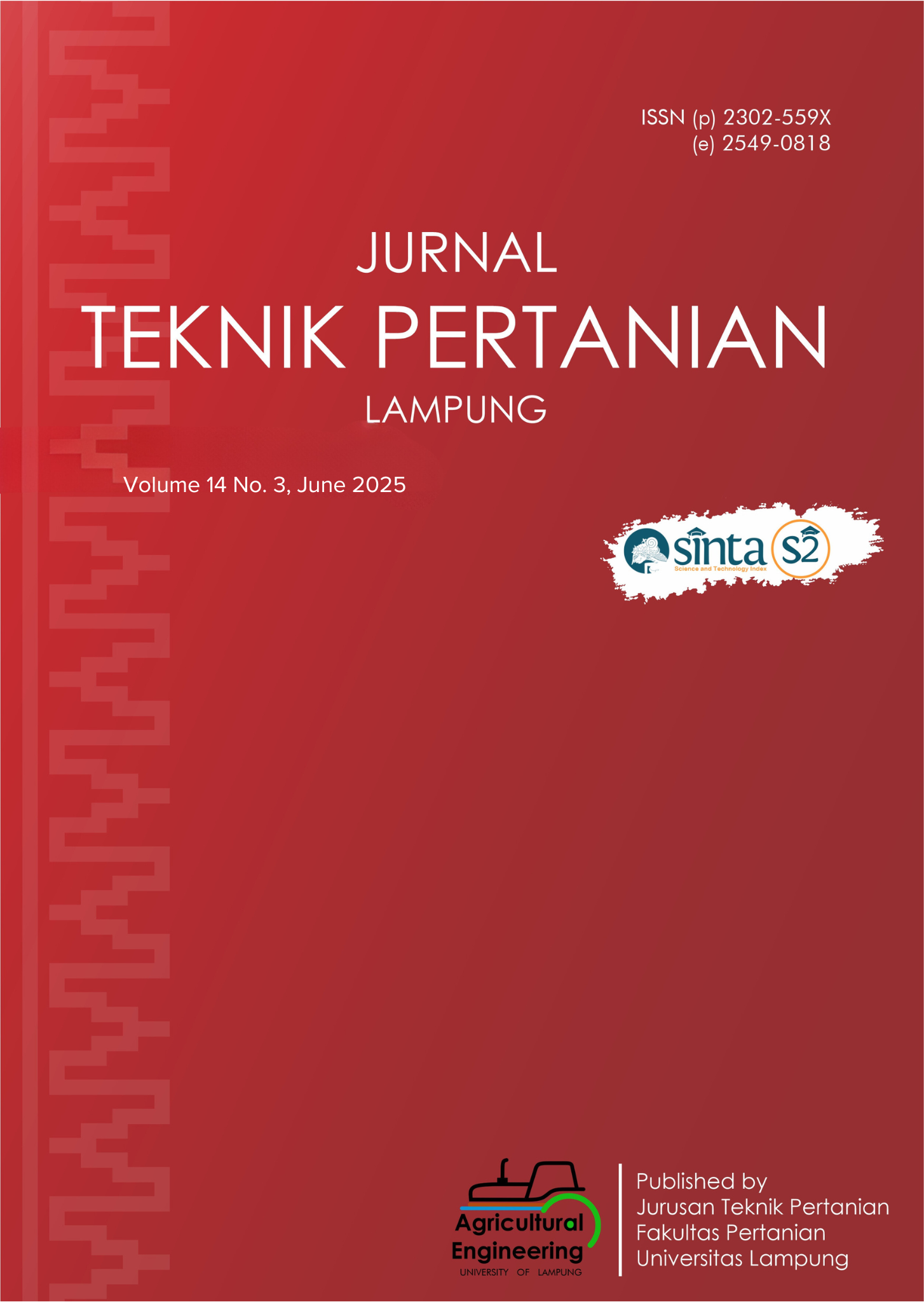The Use of Organic Fertilizer to Enhance Soil Water Availability and Promote the Growth of Tomatoes in Sandy Loam Soils
DOI:
https://doi.org/10.23960/jtep-l.v14i3.1034-1039 Abstract View: 155
Abstract View: 155
Abstract
The use of organic fertilizer has been shown to improve soil structure and promote plant root growth, particularly in critical areas with limited water resources for agricultural activities. This study aimed to evaluate the effect of organic fertilizer application on the soil’s water holding capacity and the growth performance of tomato. The experiment was conducted using a randomized complete blocs design with six treatments, each replicated three times. The treatments included P0 (0 Mg/ha), P1 (5 Mg/ha), P2 (10 Mg/ha), P3 (15 Mg/ha), P4 (20 Mg/ha), and P5 (25 Mg/ha). The findings revealed that organic fertilizer application significantly influenced soil organic carbon levels, bulk density, hydraulic conductivity, and soil water availability. Additionally, the increased soil organic carbon led to noticeable improvements in shoot dry weight, total root length, and root dry weight of tomatoes. This study found that the availability of organic carbon has very strong correlation with tomatoes growth and soil water availability.
Keywords: Organic Carbon, Sandy Soils Texture, Soil Structure, Water Retention.
Downloads
References
Ankenbauer, K.J., & Loheide, S.P. (2016). The effects of soil organic matter on soil water retention and plant water use in a meadow of the Sierra Nevada, CA. Hydrological Processes, 31(4), 891–901. https://doi.org/10.1002/hyp.11070
Ansar, M., Bahrudin, B., & Tangkesalu, D. (2021). Introduksi teknologi budidaya bawang merah berdasarkan standar Good Agriculture Practices (GAP) pada sentra produksi di Desa Olobojo Kec. Sigi-Biromaru Kabupaten Sigi. MOSINTUVU: Jurnal Pengabdian Pada Masyarakat, 2(2), 35-43.
Atkinson, D. (2000). Root characteristics: Why and what to measure. In: Smit, A.L., Bengough, A.G., Engels, C., van Noordwijk, M., Pellerin, S., van de Geijn, S.C. (eds) Root Methods. Springer, Berlin, Heidelberg., 1–32. https://doi.org/10.1007/978-3-662-04188-8_1
Blanco-Canqui, H., Wienhold, B.J., Jin, V.L., Schmer, M.R., & Kibet, L.C. (2017). Long-term tillage impact on soil hydraulic properties. Soil and Tillage Research, 170, 38–42. https://doi.org/10.1016/j.still.2017.03.001
Bonfante, A., Basile, A., & Bouma, J. (2020). Exploring the effect of varying soil organic matter contents on current and future moisture supply capacities of six Italian soils. Geoderma, 361, 114079. https://doi.org/10.1016/j.geoderma.2019.114079
Bouajila, K., & Sanâa, M. (2011). Effects of organic amendments on soil physico-chemical and biological properties. Journal of Materials and Environmental Sciences, 2, 485-490.
Brar, B.S., Singh, J., Singh, G., & Kaur, G. (2015). Effects of long term application of inorganic and organic fertilizers on soil organic carbon and physical properties in maize–wheat rotation. Agronomy, 5, 220-238. https://doi.org/10.3390/agronomy5020220
Briassoulis, H. (2019). Combating land degradation and desertification: The land-use planning quandary. Land, 8(2), 27. https://doi.org/10.3390/land8020027
Chen, M., Zhang, S., Liu, L., Wu, L., & Ding, X. (2021). Combined organic amendments and mineral fertilizer application increase rice yield by improving soil structure, p availability and root growth in saline-alkaline soil. Soil and Tillage Research, 212, 105060. https://doi.org/10.1016/j.still.2021.105060
Dutal, H., & Reis, M. (2020). Determining the effects of land use on soil erodibility in the Mediterranean highland regions of Turkey: a case study of the Korsulu stream watershed. Environmental Monitoring and Assessment, 192(3), 1–15. https://doi.org/10.1007/s10661-020-8155-z
Eden, M., Gerke, H.H., & Houot, S. (2017). Organic waste recycling in agriculture and related effects on soil water retention and plant available water: a review. Agronomy for Sustainable Development, 37, 21. https://doi.org/10.1007/s13593-017-0419-9
Głąb, T., Żabiński, A., Sadowska, U., Gondek, K., Kopeć, M., Mierzwa-Hersztek, M., & Tabor, S. (2018). Effects of co-composted maize, sewage sludge, and biochar mixtures on hydrological and physical qualities of sandy soil. Geoderma, 315, 27–35. https://doi.org/10.1016/j.geoderma.2017.11.034
Grunwald, D., Kaiser, M., & Ludwig, B. (2016). Effect of biochar and organic fertilizers on c mineralization and macro-aggregate dynamics under different incubation temperatures. Soil and Tillage Research, 164, 11–17. https://doi.org/10.1016/j.still.2016.01.002
Hussain, R., Ravi, K., & Garg, A. (2020). Influence of biochar on the soil water retention characteristics (SWRC): Potential application in geotechnical engineering structures. Soil and Tillage Research, 204. https://doi.org/10.1016/j.still.2020.104713
Jindo, K., Martim, S.A., Navarro, E.C., Pérez-Alfocea, F., Hernandez, T., Garcia, C., Aguiar, N.O., & Canellas, L.P. (2012). Root growth promotion by humic acids from composted and non-composted urban organic wastes. Plant and Soil, 353, 209–220. https://doi.org/10.1007/s11104-011-1024-3
Kobierski, M., Kondratowicz-Maciejewska, K., Banach-Szott, M., Wojewódzki, P., & Peñas Castejón, J.M. (2018). Humic substances and aggregate stability in rhizospheric and non-rhizospheric soil. Journal of Soils and Sediments, 18(8), 2777–2789. https://doi.org/10.1007/s11368-018-1935-1
Leelamanie, D.A.L., & Karube, J. (2010). Effects of hydrophobic and hydrophilic organic matter on the water repellency of model sandy soils. Soil Science and Plant Nutrition, 55(4), 461-467. https://doi.org/10.1111/j.1747-0765.2009.00388.x
Li, Q., Fu, Q., Li, T., Liu, D., Hou, R., Li, M., & Gao, Y. (2022). Biochar impacts on the soil environment of soybean root systems. Science of the Total Environment, 821, 153421. https://doi.org/10.1016/j.scitotenv.2022.153421
Libohova, Z., Seybold, C., Wysocki, D., Wills, S., Schoeneberger, P., Williams, C., Lindbo, D., Stott, D., & Owens, P.R. (2018). Reevaluating the effects of soil organic matter and other properties on available water-holding capacity using the national cooperative soil survey characterization database. Journal of Soil and Water Conservation, 73(4), 411–421.
Liu, Z.J., Zhou, W., Shen, J.-B., Li, S.-T., Liang, G.-Q., Wang, X.-B., Sun, J.-W., & Ai, C. (2014). Soil quality assessment of acid sulfate paddy soils with different productivities in Guangdong Province, China. Journal of Integrative Agriculture, 13(1), 177–186. https://doi.org/10.1016/s2095-3119(13)60594-8
Minasny, B., & McBratney, A.B. (2018). Limited effect of organic matter on soil available water capacity. European Journal of Soil Science, 69(1), 39–47. https://doi.org/10.1111/ejss.12475
Qian, Z., Tang, L., Zhuang, S., Zou, Y., Fu, D., & Chen, X. (2020). Effects of biochar amendments on soil water retention characteristics of red soil at south China. Biochar, 2, 479–488. http://dx.doi.org/10.1007/s42773-020-00068-w
Ramos, M.C. (2017). Effects of compost amendment on the available soil water and grape yield in vineyards planted after land levelling. Agricultural Water Management, 191, 67–76. https://doi.org/10.1016/j.agwat.2017.05.013
Salvia, R., Egidi, G., Vinci, S., & Salvati, L. (2019). Desertification risk and rural development in Southern Europe: Permanent assessment and implications for sustainable land management and mitigation policies. Land, 8(12), 191. https://doi.org/10.3390/land8120191
Vogelmann, E.S., Reichert, J.M., Prevedello, J., Consensa, C.O.B., Oliveira, A.É., Awe, G.O., & Mataix-Solera, J. (2013). Threshold water content beyond which hydrophobic soils become hydrophilic: The role of soil texture and organic matter content. Geoderma, 209–210, 177–187. https://doi.org/10.1016/j.geoderma.2013.06.019
Zhang, Y.-W, & Shangguan, Z.-P. (2016). The change of soil water storage in three land use types after 10 years on the Loess Plateau. Catena, 147, 87–95. https://doi.org/10.1016/j.catena.2016.06.036
Zhou, H., Fang, H., Mooney, S.J., & Peng, X. (2016). Effects of long-term inorganic and organic fertilizations on the soil micro and macro structures of rice paddies. Geoderma, 266, 66–74. https://doi.org/10.1016/j.geoderma.2015.12.007
Downloads
Published
How to Cite
Issue
Section
License
Authors who publish with this journal agree to the following terms:
Authors retain copyright and grant the journal right of first publication with the work simultaneously licensed under a Creative Commons Attribution-ShareAlike 4.0 International Lice that allows others to share the work with an acknowledgement of the work's authorship and initial publication in this journal.
Authors are able to enter into separate, additional contractual arrangements for the non-exclusive distribution of the journal's published version of the work (e.g., post it to an institutional repository or publish it in a book), with an acknowledgement of its initial publication in this journal.
Authors are permitted and encouraged to post their work online (e.g., in institutional repositories or on their website) prior to and during the submission process, as it can lead to productive exchanges, as well as earlier and greater citation of published work (See The Effect of Open Access).
Jurnal Teknik Pertanian Lampung

JTEPL is licensed under a Creative Commons Attribution-ShareAlike 4.0 International License.













